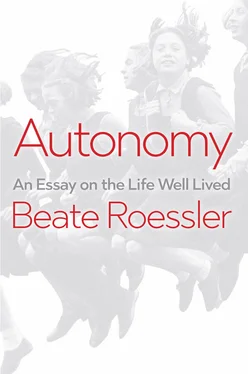“All intellectual and artistic endeavors, even jokes, ironies, and parodies, fare better in the mind of the crowd when the crowd knows that somewhere behind the great work or the great spoof it can locate a cock and a pair of balls.” 41This is The Blazing World ’s opening salvo, which prefigures the theme of the entire novel. It comes from a letter written by Harriet Burden, the novel’s protagonist, and quoted by the “editor” of her literary estate: her notes, diaries, and letters. Hustvedt’s novel portrays the life of a feminist artist in a patriarchal society in mostly subtle, at times coarse, often intricate, and extremely intelligently constructed ways. Harriet “Harry” Burden is a multimedia artist, the creator of magnificent, large-scale installations in New York, and the wife of an extraordinarily successful art dealer, Felix Lord (one should note the names). She has never had any real success as an artist, however, and so, after the death of her husband, she resorts to a trick. Successively presenting her artworks to the public under the names of three young men, she creates the great breakthrough she had hoped for. Only with the last of the three male artists do things go wrong (because he acts as though the installations are actually his own), but this is in no way the most important aspect of the plot or the novel. The Blazing World plays with a variety of literary forms (academic essays, notebooks, interviews, diaries, stories) from a variety of different perspectives (Harriet Burden, her family, her collaborators, her friends). The narrative form of the novel reflects the fragmented, multifaceted life of its protagonist. Burden writes in her diary about Margaret Cavendish (who is also the source of the novel’s title): “The duchess is a dreamer. Her characters wield their contradictory words like banners. She cannot decide. Polyphony is the only route to understanding. Hermaphroditic polyphony .” 42The sexism of the patriarchal art world forces Burden to mask herself – it forces her into different roles and identities that are incompatible with each other. “The path to truth is doubled, masked,” and to the three works that she plants on the young men she gives the collective title Maskings . 43“We live inside our categories,” she writes, “and we believe in them, but they often get scrambled. The scrambling is what interests me. The mess.” 44And this “mess” of categories, (gender) identities, and value systems can only be endured with fundamental ambivalences.
Hustvedt shows us that Burden feels alienated from the values of the patriarchal art world but at the same time is a loving wife to Felix Lord, one of this world’s most successful representatives, and a loving mother to their children. As a wife, she profits from the world that excludes her as an artist. As an artist she is excluded, but, equipped with her masks, she still endeavors to be successful in this world from this very position. As I mentioned above, Benson calls individuals who live in such identity conflicts “authentically ambivalent.” They “take ownership” of both sides and see themselves as incapable of living any other way. Harriet Burden is fundamentally ambivalent, but she is in no way alienated from her ambivalent self. She wants to be a person for whom there is not yet a place in existing cultural values systems. At the same time, she also wants to be a person who already has a proper place: a recognized feminist artist as well as a glamorous hostess and wife of a brilliant man. She is ambivalent because she cannot reconcile her different roles and identities with each other but instead must switch between them. In this sense, by the way, we can also conceive of this form of ambivalence as a potential source of social criticism, as we can interpret it as a critique of precisely the kinds of conditions that compel individuals to live in such profound ambivalence.
Autonomy and the acceptance of conflicts
I said at the outset that this chapter is concerned with the question of whether and how we can deal with our everyday experiences of ambivalence from the perspective of autonomy, and that I am interested in the full spectrum of a concept of ambivalence. By now I think it should be clear that theories that seek to banish ambivalence entirely from the network of desires, reflections, and reasons that guide our actions are rather unconvincing, but that an autonomous person nonetheless must stand behind her actions, at least in the sense that she not vacillate or constantly fall into uncertainty. Even if an autonomous person has an ambivalent self, she knows what she wants with the necessary clarity. Thus she must be sufficiently sovereign in coping with her ambivalences. She must be able to make decisions and not confuse ambivalence with skepticism. Once she has decided on a course of action, she can accept her conflicting desires and the reasons in favor of the rejected option without necessarily becoming skeptical of her choice. 45
We have seen that there are many different possible ways to deal with ambivalences. We can integrate, tolerate, accept, or compartmentalize them. We can reconcile them with each other, make compromises, or try to switch between identities. These are all possible strategies for coping reasonably with ambivalences, and they are more realistic and more suitable for daily life than strategies of externalization. Autonomy, then, can straightforwardly be understood as reasonably and adequately coping with ambivalences, with the irreconcilability and contingency of desires and possibilities, with the complexity of the question of how we want to live. Of course, we are not always ambivalent, nor are we ambivalent in every area of our lives. But when and where we are, this does not make us irrational or heteronomous. Calmly (like Frank Bascombe) coming to terms with ambivalent conflicts, emotions, decisions, finitude – that is, coming to terms with ourselves – thus clearly appears to be an expression of autonomy. These ambivalences do not stand in the way of a self-determined, well-lived life.
1 1 Sylvia Plath, The Bell Jar (New York: HarperCollins, 1996 [1971]), 94.
2 2 Harry Frankfurt, “The Faintest Passion,” Proceedings and Addresses of the American Philosophical Association 66(3) (1992), 5‒16 (9).
3 3 Cf. Paul Benson, “Taking Ownership: Authority and Voice in Autonomous Agency,” in John Christman and Joel Anderson (eds), Autonomy and the Challenges to Liberalism: New Essays (Cambridge: Cambridge University Press, 2009), 101‒26; Marina Oshana, “Autonomy and Self-Identity,” in ibid., 77‒100; and Cheshire Calhoun, “Standing for Something,” Journal of Philosophy 92 (1995): 235‒60.
4 4 Marya Schechtman, “Making Ourselves Whole: Wholeheartedness, Narrative, and Agency,” Ethical Perspectives 21 (2014): 175‒98 (180).
5 5 Amélie Oksenberg Rorty, “A Plea for Ambivalence,” in Peter Goldie (ed.), The Philosophy of Emotion (Oxford: Oxford University Press, 2010), 425‒44; Amélie Oksenberg Rorty, “Akrasia and Conflict,” Inquiry 23 (1980): 193‒212; Steve Harrist, “A Phenomenological Investigation of the Experience of Ambivalence,” Journal of Phenomenological Psychology 37 (2006): 85‒114. See also Richard Wollheim, The Thread of Life (New Haven: Yale University Press, 1984), 174‒82; Harry Frankfurt, “The Faintest Passion”; and “Identification and Wholeheartedness,” The Importance of What We Care About: Philosophical Essays (Cambridge: Cambridge University Press, 1998), 159‒76. I return to the difference between practical and theoretical conflicts in greater detail below.
6 6 Sigmund Freud, “The Dynamics of Transference,” in James Strachey (ed.), The Standard Edition of the Complete Psychological Works of Sigmund Freud, vol. XII (1911‒1913): The Case of Schreber, Papers on Techniques and Other Works (London: The Hogarth Press, 1958), 97‒108 (105f.).
Читать дальше












